Kingdom Fungi Order Lecanorales | Scientific name Erioderma pedicellatum Rank Species | |
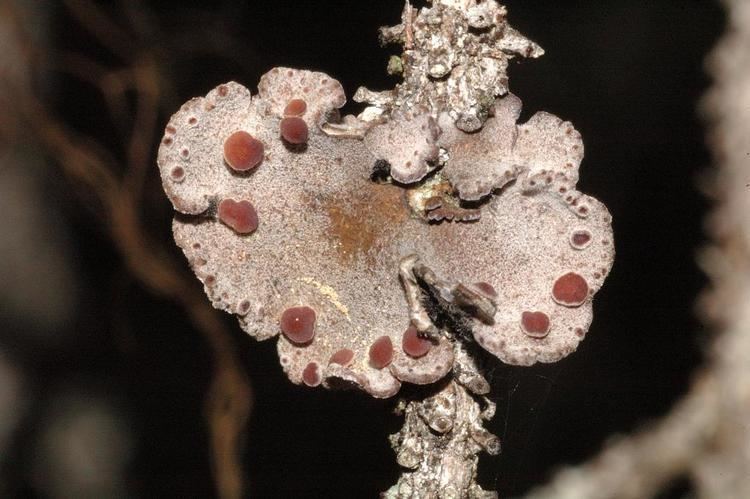 | ||
Similar Erioderma, Pannariaceae, Fuscopannaria, Pannaria, Lobaria scrobiculata | ||
Erioderma pedicellatum is a medium-sized, foliose lichen in the family Pannariaceae, commonly called boreal felt lichen because of its fuzzy appearance. It grows on trees in damp boreal forests along the Atlantic coast, as well as in southcentral Alaska. It is currently one of the most endangered lichens in the world.
Contents
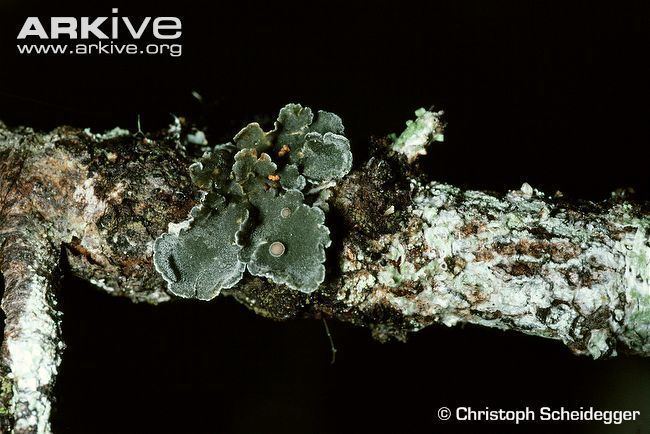
Description
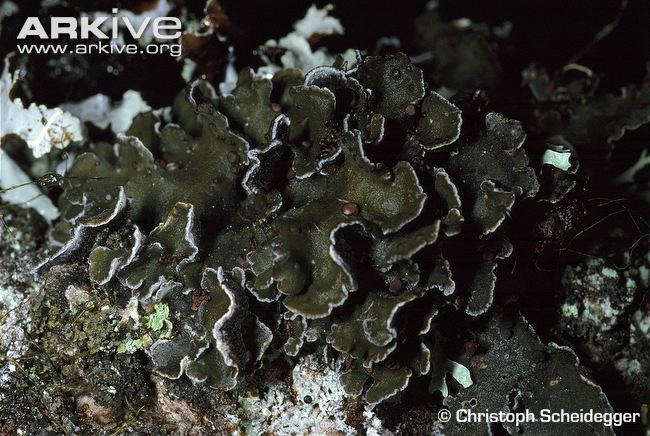
Erioderma pedicellatum is a foliose cyanolichen with lobes 2–5 cm across, and occasionally reaching 12 cm in diameter. It has a distinctively fuzzy upper surface that is greyish-brown when dry and slate-blue when moist. The underside is white, and its edges usually curl upwards, giving it the appearance of having a white fringe. It differs from the two other North American species of Erioderma by lacking soredia, and by having small, reddish-brown apothecia on its upper surface.
Taxonomy and naming
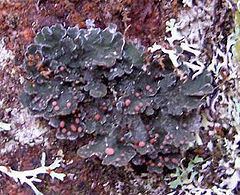
Erioderma pedicellatum was first collected in 1902 from Campobello Island, Charlotte County, New Brunswick, Canada, by William Gilson Farlow. It was originally identified as a species of Pannaria and named P. pedicellata by French botanist Auguste-Marie Hue. It remained in this genus until 1972 when it was reexamined by the Norwegian botanist Per Magnus Jørgensen and placed in the genus Erioderma as E. pedicellatum. It is an unusual species within that genus, both because of its laminal apothecia (lacking in other Erioderma) and its boreal distribution. Erioderma pedicellatum has also been incorrectly called E. boreale.
Distribution and ecology
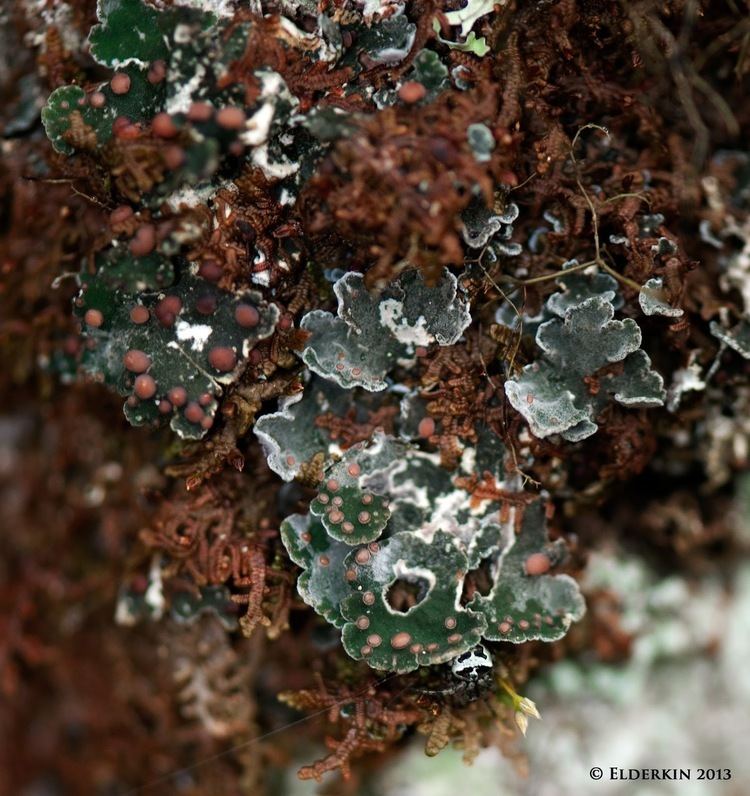
Erioderma pedicellatum is an amphi-Atlantic species that was once prevalent in Norway and Sweden as well as the provinces of New Brunswick, Nova Scotia, and Newfoundland in Atlantic Canada. Very recently, a small population was discovered in Denali area of Alaska, increasing the known range of the species. The last known population in Europe is located in Hedmark county, Norway. It has disappeared from Sweden and most areas of Atlantic Canada. It is no longer found in New Brunswick, and as of 2009 there were fewer than 200 individuals known in Nova Scotia. The remaining habitat in Newfoundland is therefore critical for the global survival of this species. Lockyer's Waters and Hall’s Gullies on the Avalon Peninsula in the southeast of Newfoundland, as well as Bay d'Espoir in the south, are three of the province's most prolific rare lichen habitats and are important for the conservation of Erioderma pedicellatum.
This lichen grows on the mossy trunks and branches of trees on slopes in areas that have a constant supply of moisture and are rich in Sphagnum moss. It is usually found on balsam fir, occasionally on black spruce, and rarely on white spruce, red maple, or white birch. It does not appear to grow directly on bare bark, and is usually found growing in association with the epiphytic liverwort Frullania asagrayana.
A healthy, mature specimen of Erioderma pedicellatum can grow at a rate of 11 to 14 mm per year, and populations of this lichen have a generation time of about 30 years. The Scytonema cyanobacteria photobiont of this lichen make it particularly sensitive to acid rain and other atmospheric pollutants. It requires relatively cool and moist oceanic climates and an open canopy, and it deteriorates rapidly on dead trees, or if habitat succession occurs that reduces or increases light availability. Altered microclimatic conditions caused by extensive logging nearby to the lichen also cause it to deteriorate.
Old growth balsam fir forests in wet areas of eastern Canada regenerate by gap replacement, which creates a mosaic of forest stands of different ages while maintaining a full or partial canopy for millennia. As a result, these forests can support a unique biota, including Erioderma pedicellatum. It appears that this mosaic of forest stands of different ages is necessary for a viable population of E. pedicellatum. Natural dispersal of E. pedicellatum is evidently possible within these old-growth forests, but there are no known examples of E. pedicellatum establishing in stands previously clear-cut.
The symbiosis
Erioderma pedicellatum, like all lichens, is a symbiosis, in this instance between an ascomycete fungus and cyanobacteria of the genus Scytonema, and is therefore capable of fixing nitrogen. This symbiotic organism may also be part of second symbiosis with the epiphytic liverwort Frullania asagrayana. The symbiosis between the free-living Scytonema and the germinating ascomycete spores of Erioderma pedicellatum is hypothesized to begin within the water sacs of Frullania asagrayana, where the fungal hyphae assimilates a cyanobacterium, and needs to develop for 5 to 10 years before it reaches a visible size. The liverwort may also benefit from the nitrogen that is being fixed by the cyanolichen growing within it. This complex relationship means that the ecological balance between Erioderma pedicellatum and its cyanobacterial symbiont (Scytonema), its host tree, and (potentially) its liverwort nursemaid (Frullania asagrayana), is very delicate and easily impacted by logging, air pollution, and other factors.
Conservation status
Erioderma pedicellatum is currently listed as endangered by the Committee on the Status of Endangered Wildlife in Canada (COSEWIC) and critically endangered by the International Union for Conservation of Nature (IUCN). No other lichen is listed by the IUCN but one fungus is considered critically endangered by the IUCN (Pleurotus nebrodensis).
Two of the main populations of Erioderma pedicellatum in Newfoundland are currently within protected areas: Jipujijkuei Kuespem Provincial Park and the Lockyer’s Waters interim protected area. The Lockyer’s Waters interim protected area was established specifically to protect this lichen. The Bay du Nord Wilderness Area in Newfoundland also includes some populations of the lichen. The Hall’s Gullies site, which also includes the endangered lichen Erioderma mollissimum, is more in jeopardy as it remains a designated cut block under the current Forest Management Operating Plan. It has been noted that populations of this lichen can decline even in protected areas, which has been linked to air pollution and introduced herbivores such as moose.
The Atlantic population of the Erioderma pedicellatum is protected in Canada under the Federal Species at Risk Act (SARA), and is the focus of an ongoing recovery strategy. Crucially, efforts are being made, through land purchases and agreements with landowners, to formally protect areas of forest that are home to this rare species. Furthermore, conservationists are engaging with private and government forest managers to encourage their participation in the mapping of boreal felt lichen habitat and the implementation of management plans that will prevent further habitat loss.
